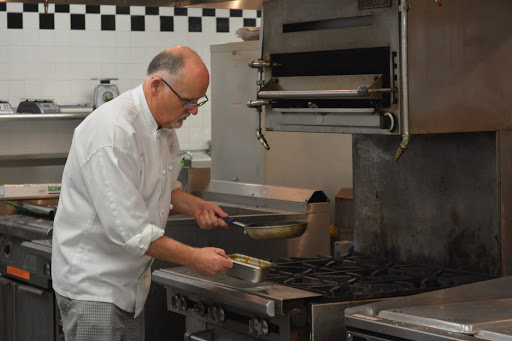F -hall is the only ground floor hallway in the school’s main body that does not have an upstairs counterpart. While its main attractions include the cafeteria and vending machines, F-hall’s food scene has more than curly fries and bagged chips. The hall is home to the culinary program, where academy students prepare meals and confectionary treats under the tutelage of Chef Ciaran Devlin.
Room F105, the actual culinary “classroom,” has China glasses and silverware for patrons and can seat a total of 36 people. It serves as the setting for events such as presentations from guest chefs of the Culinary Institute of America and food services for clubs and faculty.
An example is the program’s Five Star Cafe, which opens for lunch every Blue day. Faculty can visit the cafe and taste the fruits of the chefs’ labors, with menu options such as empanadas, curry and salads.
“I really am impressed with what they make in there,” administrative assistant Kathy Veoni said. “The work they do is great and the food tastes really good.”
The program’s kitchen boasts features like a walk-in fridge and freezer, a double stack convection oven, tilt skillet, braising pan, double door steamer, slab top range, grills and a commercial dishwasher.
Devlin requires students come to class in full uniform, complete with hat, jacket, apron and pants.
The culinary program’s logo is stitched on, as well as the chefs’ names. Seeing as students are the ones preparing everything in fully equipped facilities, Devlin trains and treats them accordingly.
“Our kitchen is actually bigger than most commercial kitchens in small, mom-and-pop restaurants,” Devlin said. “I want my students to do a combination of things. I need [my students] to know how to set up the kitchen, and once the kitchen is set up they need to know how to work with knives.”
In the fast-paced environment of a commercial kitchen, chefs are always under pressure.
When cooking comes with a certain degree of stress, demanding a high degree of accuracy and precision, culinary student and senior Chris Franco said baking offsets that stress well.
“My favorite thing to do in the class is work with the pastries,” Franco said. “With cooking, you just have to be more precise with things. Chopping things up really fast and precisely is not really something I’m good at. With baking once you know how to weigh and measure things like butter, flour and sugar, it can be turned into a lot of different things like cinnamon buns, tarts and pastries.”
The program is self-funded with the profit they make from selling the food.
Students also participate in events like the Feeding Academic Success Competition, where they can win money as well as supplies for the kitchen.
Taking the academy class gives students experience working in a professional kitchen, which prepares them to go into a culinary job in the future if they so choose.
2019-10-29

